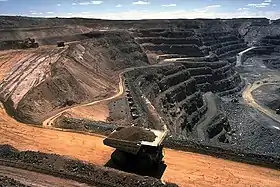Exploitation minière
L'extraction minière ou exploitation minière est l'activité consistant à extraire de la terre des minerais précieux ou d'autres matériaux géologiques utiles, en général du minerai présent dans un lode, une veine, un gisement, un filon ou un placer. Les couches de minéraux forment une ressource que l'exploitation minière prélève à des fins de vente.


Les minerais obtenus par extraction sont des métaux, du charbon, du schiste bitumineux, des gemmes, du calcaire, de la craie, des pierres de taille, du chlorure de sodium, de la potasse, du gravier et de l'argile. Les industries d'extraction, au sens large, incluent les ressources non renouvelables comme le pétrole, le gaz naturel et même l'eau fossile.
Les industrie d'extraction modernes utilisent la prospection pour trouver des minerais, l'analyse des bénéfices potentiels à l'extraction, l'extraction des matériaux puis, une fois la mine fermée, elles procèdent à la restauration du terrain (en)[1].
Les activités d'extraction minière tendent à créer des effets négatifs sur l'environnement, à la fois avant et après l'exploitation. Par conséquent, la plupart des nations du monde possèdent des réglementations pour limiter ces effets. La sécurité des infrastructures minières (en) a également évolué pour diminuer les risques.
Références
- (en) Cet article est partiellement ou en totalité issu de l’article de Wikipédia en anglais intitulé « Mining » (voir la liste des auteurs).
- Georg Agricola et Herbert Hoover (MBLWHOI Library), De re metallica, New York, Dover Publications, (lire en ligne)
Annexes
Bibliographie
- Woytinsky, W.S., and E.S. Woytinsky. World Population and Production Trends and Outlooks (1953) pp. 749–881; with many tables and maps on the worldwide mining industry in 1950, including coal, metals and minerals
- Ali, Saleem H. (2003). Mining, the Environment and Indigenous Development Conflicts. Tucson AZ: University of Arizona Press.
- Ali, Saleem H. (2009). Treasures of the Earth: need, greed and a sustainable future. New Haven and London: Yale University Press
- Chaim Even-Zohar, From Mine to Mistress: Corporate Strategies and Government Policies in the International Diamond Industry, Mining Journal Books, (ISBN 978-0-9537336-1-3), p. 555
- Geobacter Project: Gold mines may owe their origins to bacteria (in PDF format)
- Bhattacharya Jayanta, Principles of Mine Planning, Wide Publishing, , 2nd éd. (ISBN 978-81-7764-480-7), p. 505
- Morrison, Tom (1992). Hardrock Gold: a miner's tale. (ISBN 0-8061-2442-3)
- John Milne. The Miner's Handbook: A Handy Reference on the subjects of Mineral Deposits (1894) Mining operations in the 19th century. The Miner's Handbook: A Handy Book of Reference on the Subjects of Mineral Deposits, Mining Operations, Ore Dressing, Etc. For the Use of Students and Others Interested in Mining Matters
- Aryee, B., Ntibery, B., Atorkui, E. (2003). "Trends in the small-scale mining of precious minerals in Ghana: a perspective on its environmental impact", Journal of Cleaner Production 11: 131–40
- The Oil, gas and Mining Sustainable Community Development Fund (2009) Social Mine Closure Strategy, Mali (in CommDev: Projects: Social Mine Closure Strategy, Mali)
- White F. (2020). Miner with a Heart of Gold: biography of a mineral science and engineering educator. Friesen Press, Victoria. (ISBN 978-1-5255-7765-9) (Hardcover) 978-1-5255-7766-6 (Paperback) 978-1-5255-7767-3 (eBook)
Articles connexes
Liens externes
- First chapter of Introductory Mining Engineering
- An introduction to geology and hard rock mining (archive)
- s:en:The New International Encyclopædia/Mining
- Portail de la mine
- Portail de la géologie
- Portail des minéraux et roches
- Portail de la production industrielle
